It’s hot. The same river that was wild and rapid, robust and fresh just a handful of months ago is now low, slow, and flat–stale. “We need rain” has been such an oft-recited mantra that it’s hardly worth uttering, and the low, clear water hasn’t been shaded by a cloud in weeks. There are no secrets on the river, save for what can be packed into the small bits of dark black shade under the sycamores.
Successful fishing always hinges on one’s ability to eliminate water–to focus on the most-probably productive. But when light and water clarity conspire to make every inch of the subsurface environment visible, that job becomes easy. Cruising bass–particularly large cruising bass–can be spotted at distance with a good pair of trained eyes, and if fish can’t be spotted, it can be reasonably assumed that those fish are tucked away in what little shade exists.
The challenge then becomes presenting a fly in a way that triggers a large, wary smallmouth that’s been living on eggshells for weeks to eat. Therein lies the fun. Personally, as an angler, “challenging” and “fun” are almost synonyms, and I’ve made technical topwater sight fishing to big fish the mainstay of my summers in the southeast.
Following are a few tips to help you take your game to the next level.
Extend Your Butt
Smallmouth bass are not often exceptionally leader-shy, even in gin clear water. What they are most definitely in those conditions is fly line-shy. When things turn technical and the fish get extra spooky, instead of lengthening my leader by extending my tippet, I extend my butt section.
Topwater offerings for summer smallmouth bass range from relatively light foam imitations to bulkier cork and hair bugs. Since accuracy is important in sight fishing a spooky fish, and since your tippet is usually the limpest portion of your leader construction and the weak link in turning over a wind-resistant fly, I try to keep it to about 18 inches or two feet in length. To distance my fly from my fly line, I carry spools of 50- and 60-lb nylon or monofilament leader material and add it to the butt of my leader to extend the length without sacrificing diameter and stiffness in the business end, which aids in turnover.
Commit to the Dead Drift
There’s a time and a place for aggressively popping poppers. Low, hot, clear, flat summer water is neither that time nor the place. In fact, I rarely fish topwater flies I’d call “poppers” in those kinds of conditions. More subtle foam and cork offerings splatted down on the surface like a natural bug and then dead drifted are usually the best tools for the job, and less is almost always more.
When a topwater bug collides with the surface and creates a splat, its presence will be noticed by nearby bass. Conditions will dictate how wide the fish’s zone of awareness is, and what their effective reaction distance is, but I generally envision fishing a 10- to 15-foot radius from the bug’s splat.
Upon impact, allow the bug to dead drift for several seconds, giving any fish that are swimming over to inspect and eat the fly transit time. In technical summer conditions, smallmouth–particularly large smallmouth–will quickly spook from any jerky, aggressive movements in a topwater fly when they’re inspecting it. There are, of course, always exceptions to this, but as a general rule, it’s important to commit to the drift. Assume the bug is being watched, and don’t move it until you’ve given any potentially interested fish adequate transit time.
Ditch the Power Tapers
Fly lines with short, aggressive tapers have their places in bass fishing. Bank-beating with large streamers, lobbing big dumbbell-eyed dredging flies–these tactics all benefit from such lines. But when accuracy and delicacy are paramount, it’s best to look elsewhere.
Technical topwater situations are best tackled with lines that have longer, more gradual tapers, as they allow you to pick up 40 or 50 feet of fly line and recast with a rear taper to a target with minimal false casting. These lines also land on the water more delicately than more aggressive tapers, and are easily mended in the event that a current seam threatens your drag-free drift.

Minimize Casting
Big smallmouth living in shallow water in late-summer are keenly aware of their surroundings, both in and out of the water. Even the slightest movement can send fish packing, especially with a bright sun present to cast shadows. Unfortunately for fly anglers, the very act of delivering a fly to its target requires quite a bit of motion, from the angler, rod, and line, all of which can spook fish.
In particularly spooky environments, and when the sun is at its highest and the fish are the most visible, I often reduce my casting activity dramatically, making fewer, but higher percentage casts. Sometimes this means almost exclusively casting at fish that I can see.
As a side note, if it proves impossible to present a fly to visible fish without spooking them, consider ignoring the mid-river fish you can see and devoting yourself to the shade-dwelling bank fish. Large shade pockets on the bank do a bit to hide approaching overhead shadows and movement.
Avoid the One-Two Punch
In the same vein as minimizing casting activity, it’s important in technical conditions to minimize one’s interaction with the surface of the water in any given zone. That means making every cast count–good or bad.
Too often, anglers are tempted to “fix” their presentation that missed its intended target by a few feet by picking up to recast, which almost always results in a second cast that’s not significantly different from the first. Regardless of how much better a second presentation might be, it’s very likely that any fish in the vicinity of your fly’s first landing became aware of its presence in their domain the second it hit the water, and became instantly spooked by that fly’s prompt exodus from the water and subsequent reentry, leaving the second, corrective cast almost no chance for a hookup.
It’s best to make the best cast you can and commit to fishing it. More times than I’d care to admit, I’ve made comically poor casts only to have the bug plop down on the surface and get the attention of a bass that traveled a good distance to eat the fly–fish that would have never been caught had I attempted to fix the first presentation immediately.
Many might consider the lowest water of summer one of the toughest times to tangle with large river smallmouth, and they might be right, to a degree. But with the right approach, this can be one of the most exciting times of year to target some of the biggest fish in the river.





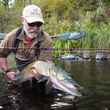
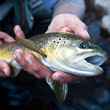
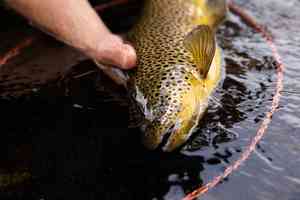













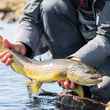




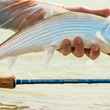



Comments
Mark Blanchette replied on Permalink
Great article Matt! Well written with wonderful words of wisdom! I’m so guilty of trying to correct a poor cast with another cast that is not much better. I need to learn to let the first cast drift! Keep up the great work!
Pages